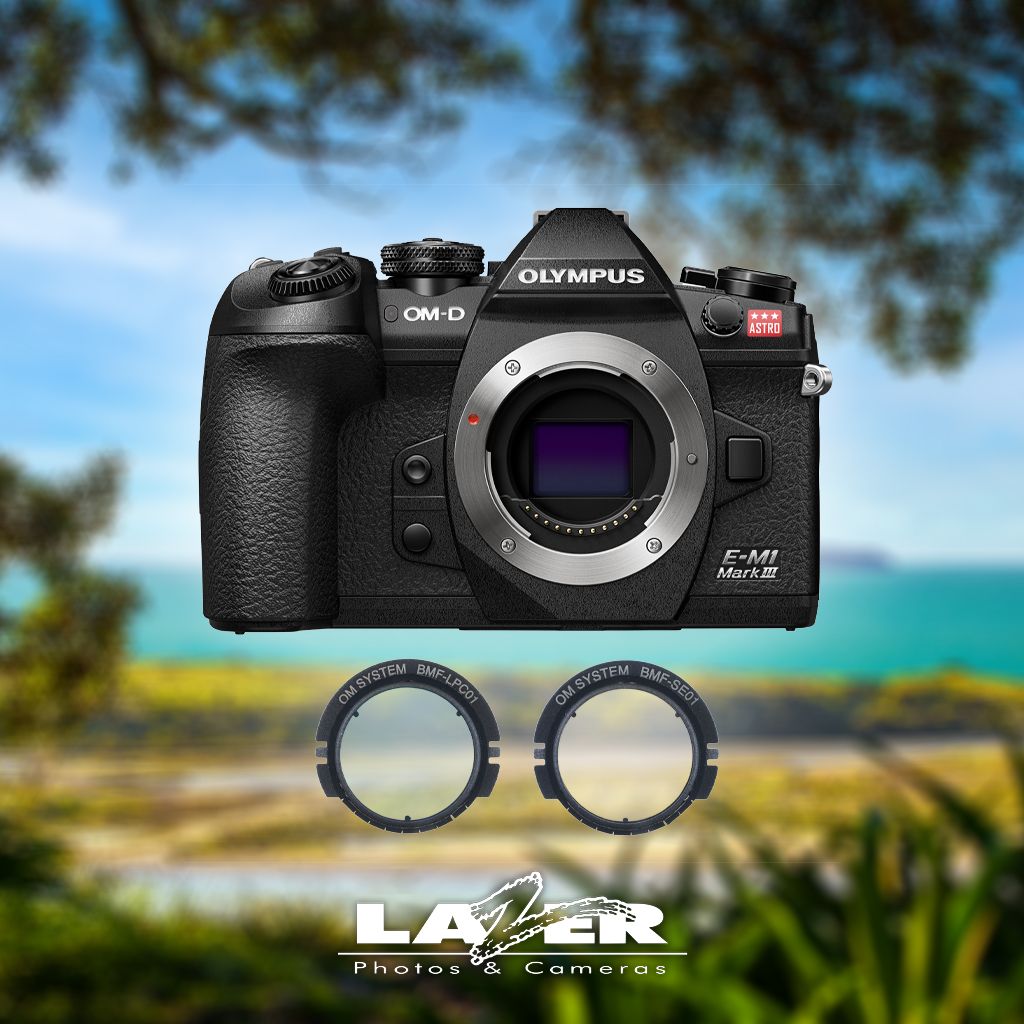Save a massive 25% on photo blockmounts, and up to $40 on selected textured canvas prints. Ends 30/09/25, T&Cs apply.
OM SYSTEM E-M1 III ASTRO Kit
SKU OMSYSTEM-EM1III-ASTRO
$3,040.00
Out Of Stock
Special order item - contact us for info & lead time
Out Of Stock
Save this product for later
OM SYSTEM E-M1 III ASTRO Kit
Product Details
Brand: OM System (Olympus)
Mount: M43
Sensor: Micro Four Thirds
The OM SYSTEM E-M1 Mark III ASTRO is a dedicated camera for astrophotography that optimises the IR cut filter located in front of the image sensor of the mirrorless single-lens camera E-M1 Mark III for astrophotography, allowing you to capture colourful red nebulae that are popular among astrophotography enthusiasts. In addition, the filters included with this product, OM SYSTEM's computational photography, and M.ZUIKO DIGITAL lenses enable a wide range of expression from starry sky photography to full-scale astrophotography, such as constellations and nebulae.
Key features
- 20.4 MP Live MOS sensor (IR cut filter located in front of the image sensor)
- IR-cut Filter in front of sensor - tuned to pass ~100% of Hα rays
- Included Light Pollution and Soft Focus Filters that clip into camera body
- Starry Sky AF to assist with focusing on stars
- TruePic IX image processor
- 3" vari-angle rear touchscreen
- 5-axis image stabilisation
Features overview
Captures Hα radiation and beautiful red diffuse nebulae that cannot be seen with the naked eye in vivid, high-resolution images
The OM SYSTEM E-M1 Mark III ASTRO has an IR cut filter in front of the image sensor that has been optimised for optical characteristics to achieve approximately 100% transmittance of Hα rays, which are important for astronomical photography. This allows you to vividly capture the beautiful shapes and colours of nebulae that emit light from Hα rays, which are difficult to capture with ordinary digital cameras.
Covers a wide range of photography scenes, from starry sky photography to astrophotography
Combining a wide variety of M.ZUIKO DIGITAL lenses, from wide-angle to telephoto, which can be selected according to the subject, you can capture beautiful images of various celestial objects, from magnificent starry skies to specific constellations and distant nebulae. In addition, using a commercially available Micro Four Thirds compatible adapter, you can attach it to an astronomical telescope and take pictures.
High Res Shot
High Res Shot is a computational photography function unique to OM SYSTEM that realises high-resolution photography using ultra-high-density pixel information obtained by shooting multiple images. Normally, Handheld High Res Shot is used when shooting handheld, but by using it with the camera fixed to a tripod or equatorial mount, the "stacking process" often used in astrophotography can be performed in one shot within the body. This not only results in high definition but also reduces noise.
The Handheld High Res Shot function on the E-M1 Mark III uses the slight misalignment that occurs during shooting to generate a high-resolution photo of approximately 50 megapixels from 16 shots. Since the images are aligned one by one when compositing, the Handheld High Res Shot function is performed with the camera fixed to a tripod to generate a composite image in which the movement of the stars due to their diurnal motion has been corrected. In addition, when using an equatorial mount, the composite image is generated, and the misalignment of the stars caused by tracking errors has been corrected.
Note: When shooting fixed on a tripod, set the shutter speed so that the exposure time per frame is such that the stars appear as dots. Depending on the scene, the intended composite image may not be obtained. In starry sky photography, the intended results may not be achieved depending on the proportion of the scenery on the ground and the composition.
Support functions for astrophotography
The camera is equipped with convenient settings for starry sky photography in the custom modes C1 and C2 (mode dial) to make it easy for those just starting astrophotography. In addition to the initial settings, such as setting AF mode to Starry Sky AF and LV Boost to On2, frequently used functions in the astrophotography workflow are assigned to buttons so that they can be called up quickly. While it is common to finish astrophotography by adjusting the colour tone and other aspects during post-shooting development, the custom modes C1 and C2 also have settings suitable for astrophotography, such as white balance and tone curve, so that natural images can be obtained even when output from the camera.
- C1 setting: This mode uses Handheld High Res Shot to capture high-resolution astronomical photographs. Use a tripod or equatorial mount to take photos.
- C2 setting: Drive mode is set to Single Shot. Image stabilisation is set to S-IS AUTO to support handheld shooting.
Note: Each setting can be changed/overwritten to suit the subject and photographer's preferences.
Two body mount filters
The ASTRO kit includes two body-mount filters designed for astrophotography:
- Light pollution cut filter (BMF-LPC01): light pollution filters cut out light from artificial light sources such as city lights and street lamps. This prevents colour casts in the night sky, allowing you to capture the original beauty of nebulae and constellations more vividly. In addition, since the area near the horizon is most susceptible to light pollution, they are also effective when photographing constellations rising in the eastern sky or setting in the western sky.
- Soft filter (BMF-SE01): The high-resolution M.ZUIKO DIGITAL lens forms a clear point image of stars, which are ideal light sources. On the other hand, because many stars are recorded as point images, representative stars may not look impressive. By using this soft filter, you can achieve the effect of blurring and emphasising point light sources, making brighter stars appear larger and more blurred, and the colours of the stars are also emphasised, making the stars and constellations stand out.
Display prices in:NZD

